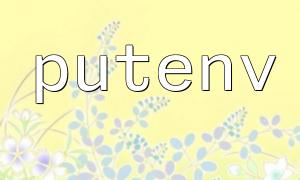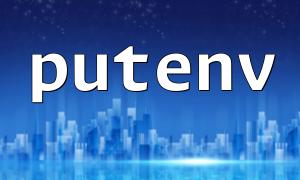In PHP development, environment variables are a very common way to configure applications. They are often used to store database connection details, API keys, runtime modes (such as development or production), and more. However, when multiple components or libraries try to set the same environment variable, overwriting may occur, which can lead to unexpected behavior.
This article explains how to properly use PHP’s putenv() function to set environment variables, avoid conflicts, and maintain application stability and maintainability.
The PHP putenv(string $assignment): bool function is used to add, modify, or remove environment variables in the current process’s environment table. It directly affects the system environment at the process level and is effective globally, working in both CLI and FPM modes.
Example:
<span><span><span class="hljs-title function_ invoke__">putenv</span></span><span>(</span><span><span class="hljs-string">"APP_ENV=production"</span></span><span>);
</span><span><span class="hljs-keyword">echo</span></span><span> </span><span><span class="hljs-title function_ invoke__">getenv</span></span><span>(</span><span><span class="hljs-string">"APP_ENV"</span></span><span>); </span><span><span class="hljs-comment">// outputs production</span></span><span>
</span></span>Multiple libraries using the same variable name: For example, if multiple libraries use API_KEY, the last value set will overwrite the previous ones.
Inconsistent configurations between development and production: Deployment may accidentally overwrite variables in the .env file.
Duplicate settings in configuration files and code: A variable defined in the .env file may be altered by a putenv() call, leading to unexpected application behavior.
Adding a prefix to your project’s environment variables helps prevent conflicts with third-party libraries. For example:
<span><span><span class="hljs-title function_ invoke__">putenv</span></span><span>(</span><span><span class="hljs-string">"MYAPP_API_KEY=abc123"</span></span><span>);
</span></span>This way, even if another library also uses API_KEY, there will be no interference.
Before calling putenv(), use getenv() to check if the variable already exists. This prevents unintentionally overwriting existing values:
<span><span><span class="hljs-keyword">if</span></span><span> (</span><span><span class="hljs-title function_ invoke__">getenv</span></span><span>(</span><span><span class="hljs-string">'MYAPP_API_KEY'</span></span><span>) === </span><span><span class="hljs-literal">false</span></span><span>) {
</span><span><span class="hljs-title function_ invoke__">putenv</span></span><span>(</span><span><span class="hljs-string">'MYAPP_API_KEY=abc123'</span></span><span>);
}
</span></span>This approach prioritizes using external configurations (such as system environment variables or container-injected variables) without forcing an overwrite.
Centralizing environment variable management through a utility function helps avoid scattered putenv() calls across the codebase. For example:
<span><span><span class="hljs-function"><span class="hljs-keyword">function</span></span></span><span> </span><span><span class="hljs-title">set_env_var</span></span><span>(</span><span><span class="hljs-params"><span class="hljs-keyword">string</span></span></span><span> </span><span><span class="hljs-variable">$key</span></span><span>, </span><span><span class="hljs-keyword">string</span></span><span> </span><span><span class="hljs-variable">$value</span></span><span>, </span><span><span class="hljs-keyword">bool</span></span><span> </span><span><span class="hljs-variable">$overwrite</span></span><span> = </span><span><span class="hljs-literal">false</span></span><span>): </span><span><span class="hljs-title">void</span></span><span> {
</span><span><span class="hljs-keyword">if</span></span><span> (</span><span><span class="hljs-variable">$overwrite</span></span> || </span><span><span class="hljs-title function_ invoke__">getenv</span></span><span>(</span><span><span class="hljs-variable">$key</span></span><span>) === </span><span><span class="hljs-literal">false</span></span><span>) {
</span><span><span class="hljs-title function_ invoke__">putenv</span></span><span>(</span><span><span class="hljs-string">"<span class="hljs-subst">{$key}</span></span></span><span>=</span><span><span class="hljs-subst">{$value}</span></span><span>");
}
}
</span></span>Usage:
<span><span><span class="hljs-title function_ invoke__">set_env_var</span></span><span>(</span><span><span class="hljs-string">'MYAPP_DB_HOST'</span></span><span>, </span><span><span class="hljs-string">'localhost'</span></span><span>);
</span></span>This encapsulation also makes it easier to extend environment variable management with more complex logic in the future.
Combine with popular tools such as vlucas/phpdotenv to read .env files while restricting overwrite behavior. For example:
<span><span><span class="hljs-variable">$dotenv</span></span> = </span><span><span class="hljs-title class_">Dotenv\Dotenv</span></span><span>::</span><span><span class="hljs-title function_ invoke__">createImmutable</span></span><span>(</span><span><span class="hljs-keyword">__DIR__</span></span>, </span><span><span class="hljs-literal">null</span></span>, </span><span><span class="hljs-literal">false</span></span>);
</span><span><span class="hljs-variable">$dotenv</span></span>-></span><span><span class="hljs-title function_ invoke__">safeLoad</span></span><span>();
</span></span>safeLoad() skips overwriting if the variable already exists, making it suitable for containerized deployments and CI/CD pipelines where injected variables should be preserved.
Environment variable overwriting is an often-overlooked problem, especially in projects involving multiple teams and many third-party libraries. By using the putenv() function wisely, adding namespace prefixes, encapsulating setting logic, and avoiding unnecessary overwrites, we can maintain better control of application behavior and prevent configuration-related bugs.
Always remember: environment variables are the “root” of your application’s configuration—handle them with care.



